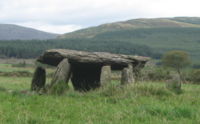
Wedge-shaped gallery grave
Encyclopedia

Ireland
Ireland is an island to the northwest of continental Europe. It is the third-largest island in Europe and the twentieth-largest island on Earth...
chamber tomb
Chamber tomb
A chamber tomb is a tomb for burial used in many different cultures. In the case of individual burials, the chamber is thought to signify a higher status for the interree than a simple grave. Built from rock or sometimes wood, the chambers could also serve as places for storage of the dead from one...
. They are so named because the burial chamber itself narrows at one end (usually decreasing both in height and width from west to east), producing a wedge shape in elevation. An antechamber
Antechamber
An antechamber is a smaller room or vestibule serving as an entryway into a larger one. The word is formed of the Latin ante camera, meaning "room before"....
is separated from the burial area by a simple jamb or sill, and the doorway generally faces west.
A distinguishing characteristic of wedge tombs is the double-walling of the gallery. They were often covered by cairn
Cairn
Cairn is a term used mainly in the English-speaking world for a man-made pile of stones. It comes from the or . Cairns are found all over the world in uplands, on moorland, on mountaintops, near waterways and on sea cliffs, and also in barren desert and tundra areas...
s, which could be round, oval or D-shaped, often with a kerb
Megalithic architectural elements
This article describes several characteristic architectural elements typical of European megalithic structures.-Forecourt:In archaeology, a forecourt is the name given to the area in front of certain types of chamber tomb...
to revet it. More are low sized, usually about 1.5 meters high, and are generally found on mountain sides, about three-quarters the way up.
Wedge tombs were built between the Irish late Neolithic
Neolithic
The Neolithic Age, Era, or Period, or New Stone Age, was a period in the development of human technology, beginning about 9500 BC in some parts of the Middle East, and later in other parts of the world. It is traditionally considered as the last part of the Stone Age...
and middle Bronze Age
Bronze Age
The Bronze Age is a period characterized by the use of copper and its alloy bronze as the chief hard materials in the manufacture of some implements and weapons. Chronologically, it stands between the Stone Age and Iron Age...
s (about 2500 to 2000BC). Today, between 500 and 550 known wedge tombs survive in Ireland, and are found predominantly in the west and north west of the island.

